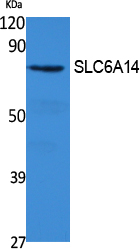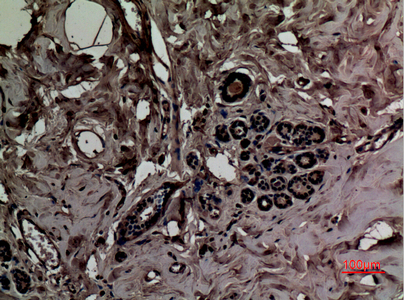SLC6A14 Polyclonal Antibody
- Catalog No.:YT5102
- Applications:WB;IHC;IF;ELISA
- Reactivity:Human;Mouse
- Target:
- SLC6A14
- Gene Name:
- SLC6A14
- Protein Name:
- Sodium- and chloride-dependent neutral and basic amino acid transporter B(0+)
- Human Gene Id:
- 11254
- Human Swiss Prot No:
- Q9UN76
- Mouse Swiss Prot No:
- Q9JMA9
- Immunogen:
- Synthesized peptide derived from the C-terminal region of human SLC6A14.
- Specificity:
- SLC6A14 Polyclonal Antibody detects endogenous levels of SLC6A14 protein.
- Formulation:
- Liquid in PBS containing 50% glycerol, 0.5% BSA and 0.02% sodium azide.
- Source:
- Polyclonal, Rabbit,IgG
- Dilution:
- WB 1:500 - 1:2000. IHC: 1:100-300 ELISA: 1:40000.. IF 1:50-200
- Purification:
- The antibody was affinity-purified from rabbit antiserum by affinity-chromatography using epitope-specific immunogen.
- Concentration:
- 1 mg/ml
- Storage Stability:
- -15°C to -25°C/1 year(Do not lower than -25°C)
- Other Name:
- SLC6A14;Sodium- and chloride-dependent neutral and basic amino acid transporter B(0+;Amino acid transporter ATB0+;Solute carrier family 6 member 14
- Observed Band(KD):
- 72kD
- Background:
- This gene encodes a member of the solute carrier family 6. Members of this family are sodium and chloride dependent neurotransmitter transporters. The encoded protein transports both neutral and cationic amino acids. This protein may also function as a beta-alanine carrier. Mutations in this gene may be associated with X-linked obesity. A pseudogene of this gene is found on chromosome X.[provided by RefSeq, May 2010],
- Function:
- disease:Genetic variations in SLC6A14 may be associated with susceptibility to X-linked obesity (OBX) [MIM:300306]. Obesity has been shown to predispose to disorders such as type 2 diabetes, coronary heart disease, hypertension, osteoarthritis, and certain cancers. Common forms of obesity are most likely caused by multiple genetic and environmental factors, and their interactions.,function:Mediates the uptake of a broad range of neutral and cationic amino acids (with the exception of proline) in a Na(+)/Cl(-)-dependent manner.,miscellaneous:Transport inhibited by BCH (2-aminobicyclo-[2.2.1]-heptane-2-carboxylic acid).,similarity:Belongs to the sodium:neurotransmitter symporter (SNF) family.,tissue specificity:Levels are highest in adult and fetal lung, in trachea and salivary gland. Lower levels detected in mammary gland, stomach and pituitary gland, and very low levels in colon, uterus,
- Subcellular Location:
- Membrane; Multi-pass membrane protein.
- Expression:
- Levels are highest in adult and fetal lung, in trachea and salivary gland. Lower levels detected in mammary gland, stomach and pituitary gland, and very low levels in colon, uterus, prostate and testis.
- June 19-2018
- WESTERN IMMUNOBLOTTING PROTOCOL
- June 19-2018
- IMMUNOHISTOCHEMISTRY-PARAFFIN PROTOCOL
- June 19-2018
- IMMUNOFLUORESCENCE PROTOCOL
- September 08-2020
- FLOW-CYTOMEYRT-PROTOCOL
- May 20-2022
- Cell-Based ELISA│解您多样本WB检测之困扰
- July 13-2018
- CELL-BASED-ELISA-PROTOCOL-FOR-ACETYL-PROTEIN
- July 13-2018
- CELL-BASED-ELISA-PROTOCOL-FOR-PHOSPHO-PROTEIN
- July 13-2018
- Antibody-FAQs
- Products Images

- Western Blot analysis of extracts from 293 cells, using SLC6A14 Polyclonal Antibody. Secondary antibody(catalog#:RS0002) was diluted at 1:20000

- Immunohistochemical analysis of paraffin-embedded human-breast, antibody was diluted at 1:100



